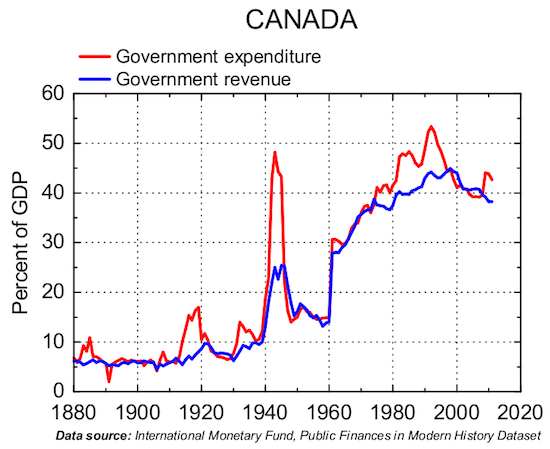By Sierra Rayne ——Bio and Archives--January 8, 2015
Canadian News, Politics | CFP Comments | Reader Friendly | Subscribe | Email Us
"[Prime Minister Stephen Harper's] government has already cut overall federal taxes and other revenues to the lowest rate they've been in over 70 years. Total federal revenues as a share of the economy declined to 14 percent in 2012/13, with tax revenues down to 11.5 percent. The federal government's revenues and taxes haven't been this low as a share of the economy since 1940."If so, that is great news. Lower levels of federal spending would -- all other things remaining constant -- free up hard-earned tax dollars in the private sector that can stimulate economic growth. Other big government supporters claim "that public spending has a much stronger impact on the economy than tax cuts do. This means that cutting public spending while also cutting taxes will lead to slower economic growth, higher unemployment and lower wage growth." Ergo, Canada's lower than desired economic growth over the past several years has been due to cuts in public spending as a percentage of the economy. Wrong again. While federal government revenues and expenditures may have declined since 2005 to 70-year lows, total government revenues and expenditures are nowhere near the levels seen seven decades ago -- due almost entirely to the growth in spending at the provincial and municipal levels.
 In fact, total government spending has increased -- not decreased -- since 2005 from 39.2 to 42.7 percent of GDP. By the reasoning of the big government proponents, Canada's economy should be booming. But it is not. Why? Because spending cuts at the federal level have been more than offset by spending increases at lower levels of government.
Back in the late 1940s after the World War II demobilization (i.e., 70 years ago), total government spending in Canada was at only 14 percent of GDP. Today, it is three-fold larger as a share of the economy. That is an explosion of big government.
See the massive increase in total government spending since the late 1950s? Magically, that is the start date of the negative correlation in Canada's annual GDP growth rate that continues up to the present. Just like the United States, the larger a share that government spending comprises within the Canadian economy, the slower the economic growth.
The recent cuts to federal spending were needed and welcome, but the real cuts to provincial and municipal governments are even more important.
In fact, total government spending has increased -- not decreased -- since 2005 from 39.2 to 42.7 percent of GDP. By the reasoning of the big government proponents, Canada's economy should be booming. But it is not. Why? Because spending cuts at the federal level have been more than offset by spending increases at lower levels of government.
Back in the late 1940s after the World War II demobilization (i.e., 70 years ago), total government spending in Canada was at only 14 percent of GDP. Today, it is three-fold larger as a share of the economy. That is an explosion of big government.
See the massive increase in total government spending since the late 1950s? Magically, that is the start date of the negative correlation in Canada's annual GDP growth rate that continues up to the present. Just like the United States, the larger a share that government spending comprises within the Canadian economy, the slower the economic growth.
The recent cuts to federal spending were needed and welcome, but the real cuts to provincial and municipal governments are even more important.View Comments
Sierra Rayne holds a Ph.D. in Chemistry and writes regularly on environment, energy, and national security topics. He can be found on Twitter at @srayne_ca